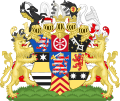The coat of arms of the German state of Hesse was introduced in 1949. It is based on the historical coat of arms of the Ludovingian landgraves of Hesse and Thuringia. The lion on the modern arms does not wear a crown or hold a sword, as it does on the arms of the Grand Duchy.[1]
| Coat of arms of Hesse | |
|---|---|
 | |
| Armiger | The Hesse State Government |
| Shield | Azure a lion rampant barry of ten argent and gules, armed or |
| Other elements | leaf crown |
YouTube Encyclopedic
-
1/3Views:6 275335444
-
Catholic Mass Facing East vs Facing the People
-
Amalie von Lerchenfeld, Baroness von Krüdener, Countess Adlerberg
-
Nativeartefacts.com Haiti Aristocracy And Nobility.
Transcription
Many ancient cultures believed east to be the direction of new life... ..several temples and monuments were built to face the rising sun Jewish tradition also revered the cardinal direction. Man's first home, Eden, was situated in the east. The tents used by the tribe of Judah during the desert wanderings were oriented eastward as was the gate of Solomon's Temple. The Psalms tell of God's powerful voice coming from the east and, in a vision, the priest and prophet Ezekiel sees the Holy Temple filled with the presence of the Lord which entered from an easterly direction. "Then he led me to the gate facing East, and there was the glory of the God of Israel coming from the east! "His voice was like the roar of many waters, and the earth shown with his glory." Ezekiel 43:1-2 The early Christians also honored the east as it was from the Mount of Olives, to the east of Jerusalem, that Christ ascended, it is also from the east that Christ will return and from where the angel the Lord will come at the end time. "Then I saw another angel come up from the east, holding the seal of the living God." Revelation 7:2 These scriptural narratives had a profound influence on Christian tradition and in the direction of Christian worship. A rule in the Apostolic Constitutions, a 4th century ecclesial manual, dictated that churches be built facing East. "And first, let the building be long, with its head to the east... let all rise up with one consent, and, looking towards the east, pray to God eastward." Apostolic Constitutions, Book II Section VII It became typical for the floor plans of Western churches, such as San Giorgio Maggiore in Venice, Italy and the Cologne Cathedral in Germany, to resemble a cross facing east. The nave, where the people gather, forms the vertical posed to the cross while the transept is the horizontal beam. The altar is located in the apse, the top of the Cross which is that the eastern end of the church. For over a thousand years Mass was celebrated with the priest and people both facing East, ad orientum, towards the rising sun. Since the tabernacle was usually reserved on the altar itself, facing east also meant that Mass was celebrated towards the Blessed Sacrament. Altars were built directly against the eastern wall of the apse being that there was no need for space behind it. Intricate alter pieces called reredos were constructed typically of wood or stone and embellished with ornate sculptures and exquisite paintings. After the Second Vatican Council however, it became more common for the priest to celebrate Mass facing the people, or, verses populum. In several churches where the altar was against the wall, it was moved forward allowing the priest to celebrate facing the people. Alternately, if the existing altar was too distant, immovable or for artistic reasons worth preserving, a second altar was constructed in front of the first. Today, the priest may face east or face the people. The two postures are equally valid and meaning has been derived from both. When celebrated verses populum, the priest and people gather together as a community with Jesus at the center. When celebrated ad orientum, the preside leads the Pilgrim Church towards the risen Christ. of
History
-
The Ludovingian lion barry in the Ingeram Codex of 1459, given as the coat of arms of the landgraves of Hesse and Thuringia
-
Coat of arms of the landgrave of Hesse in Siebmacher's Wappenbuch (1703)[2]
-
Lesser coat of arms of the Grand Duchy of Hesse, using the coat of arms of the duchy itself, with the crown of a Grand Duchy and two lions as supporters (1806 to 1918)
-
Greater coat of arms of the Grand Duchy of Hesse in 1902
-
The coat of arms of the Prussian province of Hesse-Nassau
-
Design by Gerhard Matzat (1949)
References
- ^ "Bedeutung und wappengeschichtliche Herkunft | Informationsportal Hessen". www.hessen.de (in German). Retrieved 2018-05-13.
- ^ Siebmacher, Johann (1703). Erneuertes und vermehrtes Wappenbuch... Nürnberg: Adolph Johann Helmers. pp. Part I Table 8.
See also
- Coat of arms of Prussia
- Coat of arms of Germany
- Coat of arms of Thuringia, which has a similar appearance.
- Origin of the coats of arms of German federal states.


![Coat of arms of the landgrave of Hesse in Siebmacher's Wappenbuch (1703)[2]](http://upload.wikimedia.org/wikipedia/commons/thumb/7/7d/Wappen_Landgraf_Hessen.gif/115px-Wappen_Landgraf_Hessen.gif)




